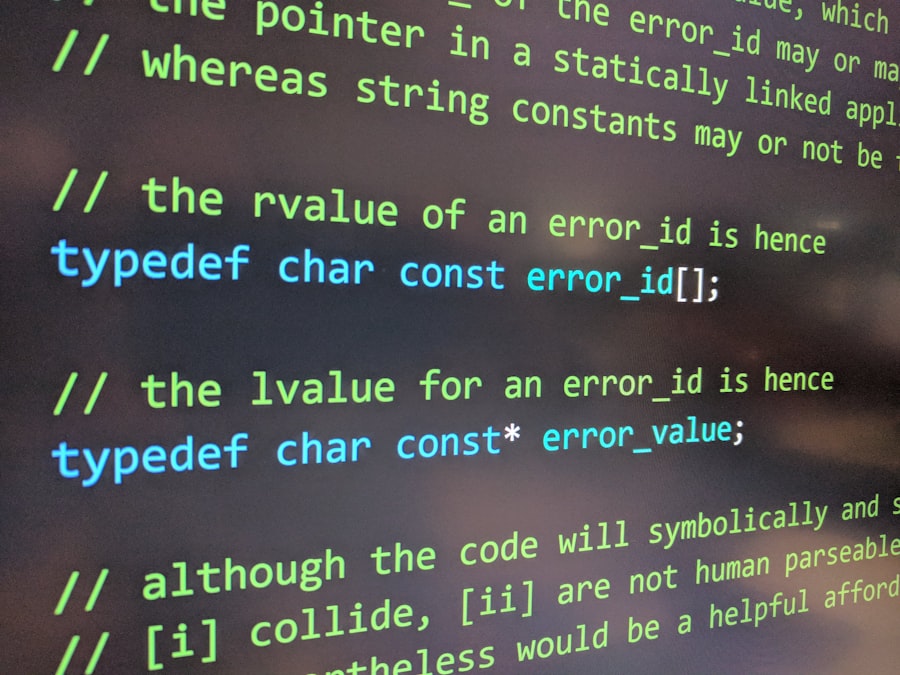In the realm of software development, grasping the requirements is the cornerstone of any successful project. We must engage with stakeholders to gather insights and expectations, ensuring that we have a comprehensive understanding of what is needed. This initial phase is not merely about collecting a list of features; it involves delving into the underlying problems that the software aims to solve.
By asking probing questions and actively listening, we can uncover nuances that may not be immediately apparent. This collaborative approach allows us to align our vision with that of our clients or end-users, setting a solid foundation for the development process. Moreover, we should recognize that requirements can evolve over time.
As we progress through the development cycle, we may encounter new challenges or opportunities that necessitate adjustments to our initial understanding. Therefore, maintaining an open line of communication with stakeholders is crucial. Regular check-ins and feedback loops can help us stay aligned with their expectations and adapt to any changes in direction.
By fostering this dynamic relationship, we can ensure that our final product not only meets but exceeds the original requirements.
Key Takeaways
- Understanding the requirements is crucial for successful software development
- Designing for scalability ensures that the software can handle increased workload
- Prioritizing security is essential to protect the software from potential threats
- Implementing version control helps in managing changes and tracking the history of the code
- Writing clean and readable code improves maintainability and reduces errors
Designing for Scalability
As we embark on the design phase of our software project, scalability must be at the forefront of our minds. We need to envision how our application will perform as user demand grows and data volumes increase. A well-architected system should accommodate future expansion without requiring a complete overhaul.
To achieve this, we can adopt modular design principles, allowing us to build components that can be independently scaled or replaced as needed. This approach not only enhances flexibility but also promotes maintainability, as we can focus on optimizing specific areas without disrupting the entire system. In addition to modularity, we should consider the underlying infrastructure that supports our application.
Leveraging cloud services and microservices architecture can provide us with the tools necessary to scale efficiently. By utilizing load balancers and distributed databases, we can ensure that our application remains responsive even under heavy traffic. Furthermore, we must anticipate potential bottlenecks and design our system to mitigate them proactively.
By thinking ahead and incorporating scalability into our design from the outset, we position ourselves for long-term success.
Prioritizing Security

In today’s digital landscape, security cannot be an afterthought; it must be woven into the fabric of our development process. As we design and build our software, we must prioritize security at every stage. This begins with understanding potential threats and vulnerabilities that could compromise our application.
We should conduct thorough risk assessments and stay informed about the latest security best practices. By adopting a proactive mindset, we can identify weaknesses before they become exploitable. Moreover, implementing security measures such as encryption, authentication, and access controls is essential.
We need to ensure that sensitive data is protected both in transit and at rest. Regularly updating our dependencies and libraries is another critical aspect of maintaining security. By keeping our software stack current, we can mitigate risks associated with known vulnerabilities.
Ultimately, fostering a culture of security awareness within our team will empower us to create robust applications that safeguard user data and maintain trust.
Implementing Version Control
| Metrics | Data |
|---|---|
| Number of developers using version control | 25 |
| Number of commits per week | 150 |
| Number of branches in the repository | 10 |
| Percentage of code coverage by version control | 85% |
Version control is an indispensable tool in our software development toolkit. It allows us to track changes to our codebase over time, facilitating collaboration among team members and providing a safety net for our work. By using a version control system like Git, we can create branches for new features or bug fixes, enabling us to experiment without jeopardizing the stability of the main codebase.
This practice not only enhances our workflow but also encourages innovation, as we can iterate on ideas without fear of losing progress. Additionally, version control aids in maintaining a clear history of our project’s evolution. We can easily revert to previous versions if necessary, making it simpler to troubleshoot issues or recover from mistakes.
Furthermore, it fosters accountability within our team; each change is attributed to a specific contributor, promoting transparency and collaboration. By embracing version control as a fundamental aspect of our development process, we enhance both our efficiency and the quality of our code.
Writing Clean and Readable Code
As we write code, clarity should be one of our primary objectives. Clean and readable code not only makes it easier for us to understand our own work but also facilitates collaboration with others on our team. We should adhere to established coding standards and conventions, ensuring consistency throughout our codebase.
This includes using meaningful variable names, organizing code logically, and adding comments where necessary to explain complex logic or decisions. Moreover, we must recognize that clean code is not just about aesthetics; it directly impacts maintainability and scalability. When we write code that is easy to read and understand, we reduce the cognitive load on ourselves and our colleagues when revisiting or modifying it in the future.
Refactoring should be an ongoing practice in our development process; by continuously improving our code’s structure without altering its functionality, we can enhance its readability and performance over time.
Conducting Regular Code Reviews

Code reviews are a vital component of our development process that fosters collaboration and knowledge sharing within our team. By reviewing each other’s work, we can catch potential issues early on and ensure adherence to coding standards. This practice not only improves the quality of our code but also serves as an opportunity for learning and growth.
We can share insights and best practices, helping each other develop stronger coding skills. Furthermore, regular code reviews promote a culture of accountability and transparency within our team. When we know that our work will be reviewed by peers, we are more likely to take extra care in writing clean and efficient code.
This collaborative approach also helps us identify areas for improvement in our processes and methodologies. By making code reviews a routine part of our workflow, we create an environment where continuous improvement is valued and encouraged.
Testing Early and Often
Testing is an integral part of the software development lifecycle that cannot be overlooked. We must adopt a mindset of testing early and often to catch bugs before they escalate into larger issues. By implementing unit tests during the development phase, we can validate individual components of our application as they are built.
This practice not only helps us identify problems quickly but also provides a safety net for future changes; if a modification breaks existing functionality, our tests will alert us immediately. In addition to unit testing, we should incorporate integration testing to ensure that different components of our application work seamlessly together. Automated testing frameworks can significantly enhance our efficiency by allowing us to run tests consistently throughout the development process.
By prioritizing testing at every stage, we can deliver higher-quality software that meets user expectations while minimizing the risk of post-release defects.
Embracing Automation
In an era where efficiency is paramount, embracing automation in our development processes is essential. We should leverage tools that automate repetitive tasks such as testing, deployment, and code formatting. By doing so, we free up valuable time that can be better spent on more complex problem-solving activities or creative endeavors.
Automation not only enhances productivity but also reduces the likelihood of human error in routine tasks. Moreover, continuous integration and continuous deployment (CI/CD) pipelines are powerful practices that allow us to automate the entire software delivery process. With CI/CD in place, every change made to the codebase triggers automated tests and deployments, ensuring that new features are integrated smoothly without disrupting existing functionality.
This streamlined approach enables us to deliver updates more frequently while maintaining high standards of quality.
Documenting Thoroughly
Thorough documentation is often an overlooked aspect of software development, yet it plays a crucial role in ensuring long-term success. As we build applications, we must document not only the code itself but also the rationale behind design decisions, architecture choices, and workflows. This documentation serves as a valuable resource for current team members as well as future developers who may work on the project down the line.
We should strive for clarity and accessibility in our documentation; it should be easy to navigate and understand for anyone who references it. Utilizing tools like wikis or dedicated documentation platforms can help us organize information effectively. Additionally, keeping documentation up-to-date is essential; as changes are made to the codebase or project scope, we must ensure that corresponding documentation reflects those updates accurately.
Fostering Collaboration and Communication
Collaboration and communication are at the heart of successful software development teams. We must cultivate an environment where team members feel comfortable sharing ideas, asking questions, and providing feedback. Regular meetings—whether they are daily stand-ups or weekly retrospectives—can facilitate open dialogue and ensure everyone is aligned on project goals.
Moreover, utilizing collaboration tools such as Slack or Microsoft Teams can enhance communication among team members, especially in remote work settings. These platforms allow us to share updates quickly and efficiently while fostering a sense of community within the team. By prioritizing collaboration and communication, we create a supportive atmosphere where creativity thrives and challenges are addressed collectively.
Continuously Improving and Refactoring
The journey of software development is one of continuous improvement; there is always room for enhancement in both our processes and code quality. We should embrace a mindset of refactoring—regularly revisiting and improving existing code without changing its external behavior. This practice allows us to optimize performance, enhance readability, and reduce technical debt over time.
Additionally, seeking feedback from team members during retrospectives can provide valuable insights into areas where we can improve as a team. By analyzing what worked well and what didn’t during a project cycle, we can implement changes that lead to more efficient workflows in future endeavors. Ultimately, by committing ourselves to continuous improvement and refactoring practices, we position ourselves for sustained success in an ever-evolving technological landscape.
In conclusion, by understanding requirements thoroughly, designing for scalability, prioritizing security, implementing version control effectively, writing clean code, conducting regular reviews, testing diligently, embracing automation, documenting thoroughly, fostering collaboration, and committing to continuous improvement, we set ourselves up for success in software development projects. Each element plays a vital role in creating high-quality applications that meet user needs while allowing us to grow as developers within a dynamic industry.
FAQs
What are software development best practices?
Software development best practices are a set of guidelines, principles, and techniques that are considered to be the most effective and efficient ways to develop high-quality software. These practices are aimed at improving the overall development process, reducing errors, and increasing the maintainability of the software.
Why are software development best practices important?
Software development best practices are important because they help ensure that the software being developed is of high quality, reliable, and maintainable. By following best practices, developers can reduce the likelihood of errors, improve the efficiency of the development process, and ultimately deliver better software to end users.
What are some common software development best practices?
Some common software development best practices include using version control systems, writing clean and maintainable code, conducting thorough testing, following coding standards, documenting the code, and using design patterns and architectural principles.
How do software development best practices benefit the development process?
Software development best practices benefit the development process by improving the quality of the software, reducing the likelihood of errors, increasing the maintainability of the code, and ultimately saving time and resources in the long run. By following best practices, developers can also collaborate more effectively and produce software that meets the needs of end users.
What are some challenges in implementing software development best practices?
Some challenges in implementing software development best practices include resistance to change from developers, lack of awareness or understanding of best practices, and the need for additional time and resources to adopt new practices. Additionally, different projects and teams may have unique requirements that make it challenging to apply best practices universally.
My friends would say that I'm creative, smart, driven, and a hard worker...and I would have to agree. I've developed technology solutions for many businesses over the last 20 years. I take pride in being a change agent and problem solver with a passion for technology and people; grasping the big picture, conceptualizing, developing, and implementing solutions while partnering closely with business leaders.
About us and this blog
We are a digital marketing company with a focus on helping our customers achieve great results across several key areas.
Request a free quote
We offer professional SEO services that help websites increase their organic search score drastically in order to compete for the highest rankings even when it comes to highly competitive keywords.
Subscribe to our newsletter!
More from our blog
See all postsRecent Posts
- Maximize Your ROI with a Top PPC Ad Agency August 21, 2025
- Maximizing ROI with Pay Per Click Agencies August 17, 2025
- Maximizing ROI with a PPC Agency August 13, 2025










